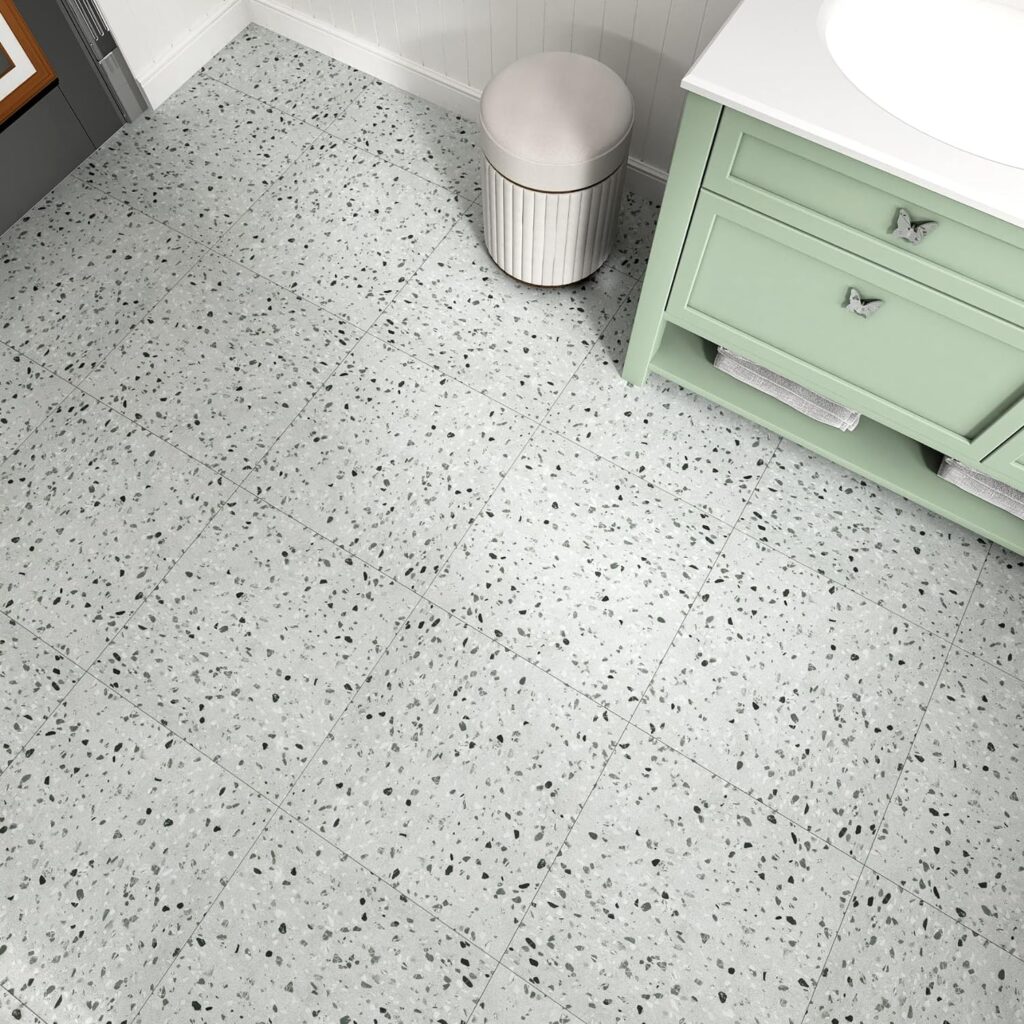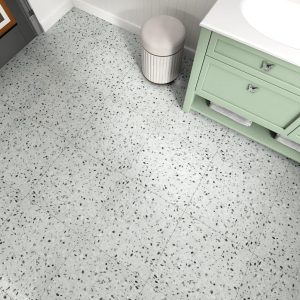In the realm of flooring, there exists a treasure—a gem that transcends mere functionality and rises to the status of artistry. Welcome to the enchanting world of epoxy terrazzo flooring, where elegance meets innovation, and beauty knows no bounds.
Imagine walking into a space where every step you take is a dance upon a canvas of exquisite design. Each tile, a masterpiece in its own right, whispers tales of craftsmanship and creativity, inviting you to immerse yourself in its timeless allure.
In this introduction, we embark on a journey—a journey of discovery and appreciation for the unparalleled beauty of epoxy terrazzo flooring. Join us as we delve deep into the heart of this captivating flooring option, uncovering its secrets, celebrating its elegance, and exploring the boundless possibilities it offers to elevate any space.

Brief overview of Epoxy Terrazzo Flooring
Epoxy Terrazzo Flooring is a sophisticated and versatile flooring solution that seamlessly combines aesthetic appeal with robust functionality. Stemming from ancient mosaic traditions, Epoxy Terrazzo has evolved into a contemporary masterpiece in interior design and architecture. This flooring material is renowned for its durability, longevity, and the limitless creative possibilities it offers to designers and architects.
Epoxy Terrazzo is composed of a blend of epoxy resin, coloured aggregates, and other additives, creating a resilient and visually stunning surface. Unlike traditional Terrazzo, Epoxy Terrazzo offers enhanced flexibility in design, allowing for intricate patterns, vibrant colours, and customised finishes.
One of the key advantages of Epoxy Terrazzo is its ability to withstand heavy foot traffic and maintain its polished appearance for years. The low maintenance requirements make it an ideal choice for a wide range of spaces, including commercial buildings, educational institutions, and residential interiors.
Furthermore, Epoxy Terrazzo is celebrated for its eco-friendly features, contributing to sustainable building practices. As an attractive, durable, and environmentally conscious flooring solution, Epoxy Terrazzo has emerged as a favoured option for those seeking both style and substance in their interior spaces.
Advantages and Disadvantage of Epoxy Terrazzo Flooring
Advantages of Epoxy Terrazzo Flooring:
Durability: Epoxy Terrazzo is renowned for its exceptional durability, making it ideal for high-traffic areas. It can withstand heavy foot traffic, making it suitable for commercial spaces and public buildings.
Aesthetic Versatility: Epoxy Terrazzo offers unparalleled design flexibility. Designers can create intricate patterns, incorporate vibrant colours, and even embed custom logos or artwork, allowing for a truly customised and visually appealing flooring solution.
Low Maintenance: Unlike some other flooring options, Epoxy Terrazzo is relatively low maintenance. Regular cleaning and occasional polishing are usually sufficient to keep it looking pristine, reducing the need for extensive upkeep
Long Lifespan: With proper installation and maintenance, Epoxy Terrazzo can have a long lifespan. This longevity adds to its cost-effectiveness over time, as it may require fewer replacements compared to some other flooring materials.
Eco-Friendly: Epoxy Terrazzo is considered environmentally friendly. It often contains recycled materials, and its durability contributes to a reduction in material consumption over the long term.
Disadvantages of Epoxy Terrazzo Flooring:
Installation Complexity: The installation of Epoxy Terrazzo can be intricate and time-consuming. It requires skilled professionals to achieve the desired results, potentially leading to higher installation costs.
Initial Cost: While the long-term durability can lead to cost savings over time, the initial cost of Epoxy Terrazzo can be higher compared to some other flooring options. This might be a consideration for budget-conscious projects.
Susceptibility to Cracking: Despite its durability, Epoxy Terrazzo can be susceptible to cracking, especially if not properly installed or if subjected to extreme temperature fluctuations. Regular maintenance and prompt repairs are essential to address any issues.
Slipperiness When Wet: Like many smooth surfaces, Epoxy Terrazzo can become slippery when wet. Adding slip-resistant additives during installation or using rugs in areas prone to moisture can mitigate this concern.
Limited DIY Options: Epoxy Terrazzo installation is a specialised skill, and it is not typically a DIY-friendly flooring option. This limits the ability of homeowners or less-experienced individuals to undertake the installation themselves. Professional installation is strongly recommended to ensure a quality result

Uses of Epoxy Terrazzo Flooring
Epoxy Terrazzo flooring has become a preferred choice for a wide range of applications due to its aesthetic versatility, durability, and functional attributes. Here are some common and innovative uses of Epoxy Terrazzo Flooring:
Commercial Spaces:
- Retail Stores: Epoxy Terrazzo is often used in retail spaces to create visually appealing and durable flooring that withstands the high foot traffic.
- Hotels: Its elegant appearance and durability make Epoxy Terrazzo a popular choice for hotel lobbies, corridors, and common areas.
- Restaurants: Epoxy Terrazzo adds a touch of sophistication to restaurant interiors, providing a durable and easy-to-clean surface.
Educational Institutions:
- Schools and Universities: Epoxy Terrazzo is suitable for educational facilities where a combination of durability and aesthetic appeal is desired.
Healthcare Facilities:
- Hospitals and Clinics: In healthcare settings, where cleanliness and durability are crucial, Epoxy Terrazzo is used in corridors, waiting areas, and public spaces.
Residential Interiors:
- Living Spaces: Homeowners often choose Epoxy Terrazzo for living rooms, kitchens, and hallways due to its customizable designs and low maintenance requirements.
- Bathrooms: Its resistance to moisture makes it a viable option for bathroom flooring.
Corporate Offices:
- Office Spaces: Epoxy Terrazzo provides a sophisticated and professional look for corporate offices, especially in entrance areas and common spaces.
Cultural and Public Spaces:
- Museums: Epoxy Terrazzo is used in museum spaces for its ability to complement various architectural styles while providing a durable and attractive flooring solution.
- Government Buildings: Government and public buildings often opt for Epoxy Terrazzo for its longevity and timeless aesthetic.
Entertainment Venues:
- Theatres and Auditoriums: Epoxy Terrazzo’s design flexibility allows for the incorporation of intricate patterns or logos, making it suitable for entertainment venues.
- Casinos: In areas with high foot traffic, such as casinos, the durability of Epoxy Terrazzo is a practical choice.
Retail Environments:
- Shopping Malls: Epoxy Terrazzo can be found in the common areas of shopping malls, providing a durable and visually appealing flooring solution.
Airports and Transportation Hubs:
- Airport Terminals: Epoxy Terrazzo is used in airport terminals for its durability and ability to withstand the constant movement of travellers and luggage.
Innovative Architectural Design:
- Art Installations: Epoxy Terrazzo can be used as a canvas for artistic expression, allowing designers to create unique and visually stunning art installations within the flooring.
- Customised Designs: The ability to embed various materials and create intricate designs makes Epoxy Terrazzo suitable for customised and innovative flooring designs.
Installation and Maintenance Tip
Professional Installation: Epoxy Terrazzo installation is a specialised process that requires skilled professionals. Hire experienced installers to ensure proper mixing, application, and finishing for a flawless result.
Surface Preparation: Adequate surface preparation is crucial. The substrate should be clean, dry, and free of any contaminants to ensure proper adhesion of the epoxy terrazzo system.
Accurate Measurements: Precise measurements of epoxy resin, aggregates, and other components are essential. Follow manufacturer guidelines meticulously to achieve the desired consistency and performance.
Temperature Control: Pay attention to temperature conditions during installation. Ideal ambient and substrate temperatures contribute to the proper curing of the epoxy, preventing issues like bubbling or uneven curing.
Customization Planning: If incorporating intricate designs or patterns, plan the layout meticulously before installation. This helps in achieving a seamless and aesthetically pleasing result.
Seam Placement: Strategically plan seam placement to minimise the visibility of joints. Properly executed seams enhance the overall appearance and durability of the flooring.
Curing Time: Allow sufficient curing time before subjecting the newly installed epoxy terrazzo to foot traffic. Following the recommended curing period ensures the flooring’s long-term durability.

Maintenance Tips for Epoxy Terrazzo Flooring:
Regular Cleaning: Implement a routine cleaning schedule using a neutral pH cleaner. This helps remove dirt and prevents the buildup of residues, maintaining the flooring’s lustre.
Avoid Harsh Chemicals: Refrain from using abrasive or acidic cleaners as they can damage the epoxy terrazzo surface. Stick to recommended cleaning agents to preserve the integrity of the flooring.
Protective Measures: Place protective pads under furniture legs to prevent scratches. Consider using entrance mats to minimise the tracking of dirt and debris onto the epoxy terrazzo surface.
Prompt Stain Removal: Address spills and stains promptly to prevent discoloration. Blot liquids and clean with a damp cloth. Avoid letting spills sit for an extended period.
Periodic Polishing: Periodically polish the epoxy terrazzo surface to maintain its shine. Consult with flooring professionals to determine the appropriate frequency and polishing products.
Avoid Sharp Objects: Prevent scratches by avoiding the use of sharp or abrasive objects on the flooring. Encourage the use of soft-bristle brooms and non-abrasive cleaning tools.
Regular Inspections: Conduct regular inspections for any signs of damage or wear. Address issues promptly to prevent minor problems from escalating.
History and Evolution of Terrazzo Flooring
Terrazzo flooring has a history that dates back to ancient times. Originating in Italy over 500 years ago, traditional terrazzo was created by Venetian construction workers who reused marble scraps and embedded them into clay or lime to form durable and decorative flooring. This early form of terrazzo became popular in palaces and grand buildings because of its elegance and longevity.
In the 20th century, cement-based terrazzo gained widespread popularity, particularly in public buildings, schools, and government institutions. Its durability and aesthetic appeal made it a preferred choice for high-traffic areas. However, cement terrazzo required thicker installations and was prone to cracking.
The evolution of terrazzo took a significant leap with the introduction of epoxy terrazzo in the 1970s. Epoxy resin replaced cement as the binder, providing greater flexibility, reduced thickness, and improved crack resistance. This innovation allowed for more vibrant color options, intricate designs, and faster installation processes.
Today, epoxy terrazzo is widely recognized as a modern upgrade to traditional terrazzo. It combines the historic charm of marble chips with advanced technology that enhances performance and versatility. Designers can now integrate logos, patterns, and even artworks into epoxy terrazzo flooring, making it a favorite for commercial spaces like airports and universities.
From ancient palaces to contemporary airports, terrazzo flooring has evolved into a symbol of durability and beauty. Epoxy terrazzo, as the latest advancement, continues this legacy while meeting the demands of modern architecture for sustainable, stylish, and long-lasting flooring solutions.
Materials Used in Epoxy Terrazzo Flooring
Epoxy terrazzo flooring is created using a blend of epoxy resin and decorative aggregates, offering both strength and beauty. The epoxy resin acts as the binder, providing flexibility, durability, and resistance to chemicals and stains. Compared to cement, epoxy resin is lighter, allows for thinner applications, and supports a wider range of colors.
The aggregates are what give terrazzo its distinctive appearance. Common materials include marble chips, quartz, granite, glass, and even recycled materials like porcelain or metal shavings. These aggregates are mixed into the epoxy or sprinkled on top before grinding and polishing. The choice of aggregate affects the color, texture, and overall style of the flooring.
Pigments and dyes are also used in epoxy terrazzo to expand design possibilities. This allows architects and designers to create vibrant colors, patterns, and even custom logos. Unlike cement terrazzo, epoxy terrazzo does not limit the color palette, enabling bold and creative designs.
Divider strips, usually made of aluminum, brass, or zinc, are another essential component. They are used to separate colors, define patterns, and control expansion. Divider strips not only enhance aesthetics but also prevent cracking by allowing controlled movement within the floor.
Lastly, sealants and top coatings are applied after grinding and polishing. These protect the surface, enhance shine, and increase resistance to stains and wear.
In short, epoxy terrazzo flooring is a sophisticated combination of epoxy resin, decorative aggregates, divider strips, and sealants. The materials work together to produce a seamless, durable, and highly customizable flooring solution suitable for any environment.
Installation Process of Epoxy Terrazzo Flooring
The installation of epoxy terrazzo flooring is a detailed process that requires professional expertise to ensure a flawless finish. It begins with preparing the subfloor, which must be clean, level, and free of cracks or moisture. Concrete subfloors are the most common base for epoxy terrazzo installations.
Once the subfloor is ready, divider strips are placed to outline the design and separate different colors or sections. These strips are usually made of aluminum or brass and act as both decorative and functional elements.
The next step is mixing epoxy resin with aggregates such as marble chips, glass, or quartz. This mixture is then poured onto the floor and spread evenly. Installers use trowels to ensure the material fills all areas and reaches the desired thickness.
After curing, which usually takes 24 to 48 hours, the surface is ground with diamond grinders to expose the aggregates and create a smooth finish. The grinding process is followed by polishing, which enhances the shine and brings out the beauty of the embedded materials.
Finally, a sealer or protective topcoat is applied to enhance durability, prevent staining, and make cleaning easier. This finishing step also improves the floor’s resistance to chemicals and wear, ensuring long-term performance.
While epoxy terrazzo installation is labor-intensive, the results are exceptional. The process allows for creative designs, seamless finishes, and long-lasting performance, making epoxy terrazzo one of the most desirable flooring systems for modern architecture.
Conclusion
In conclusion, Epoxy Terrazzo Flooring stands as a testament to the harmonious marriage of art and functionality in the world of interior design. Its roots in ancient mosaic traditions have evolved into a contemporary flooring masterpiece that graces a diverse range of spaces with elegance and durability.
The most important frequently asked questions about Epoxy Terrazzo Flooring
Is epoxy terrazzo durable?
Yes, it is highly durable, long-lasting, and resistant to wear.
Is epoxy terrazzo flooring waterproof?
Yes, the epoxy matrix makes it non-porous and waterproof.
Can epoxy terrazzo be used in homes?
Yes, it’s increasingly popular for modern residential designs.
Is epoxy terrazzo slippery?
When polished, it can be slippery; slip-resistant finishes are available.




